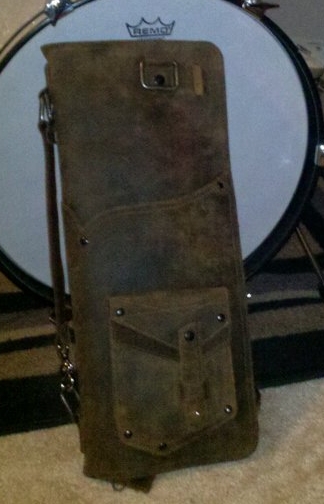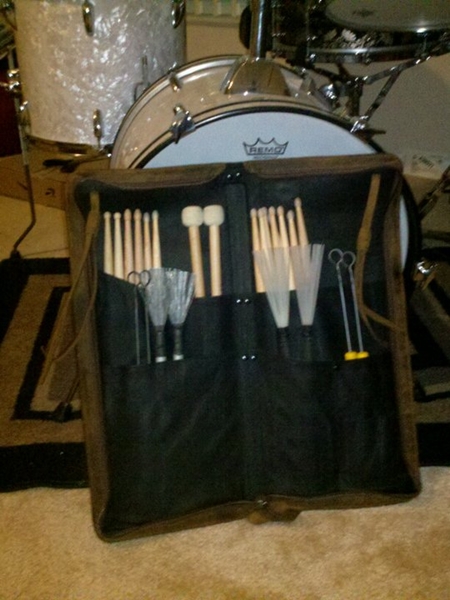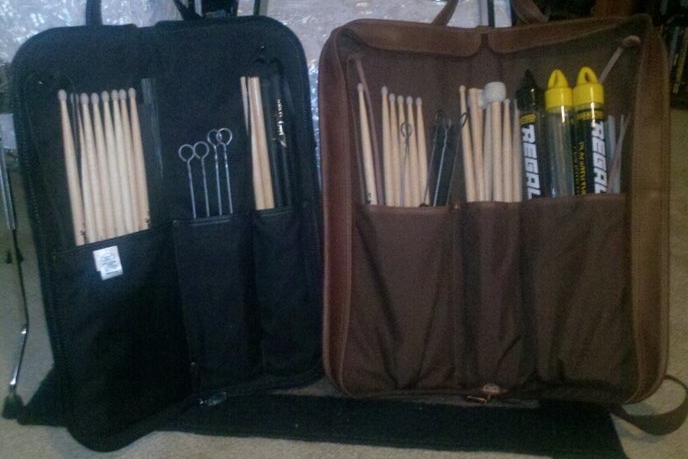At the top of the food chain, in my opinion, is the Anthology Gear Wear stick bag. I own one, shown in the following photos:

Rear

Open

Note the size (pretty large), capacity (considerable) and looks (uber cool). Although this bag has rawhide straps to hang it from a floor tom, it is so heavy and dense that it would kill the drum's resonance. Also note that the pockets are not nylon like most other high end bags, but, instead, are leather.
This is truly the epitome of stick bags. Also, if you do not like the finish, called "black whiskey" you can have one made in carbon black instead. There is ample pouch space - shown in the front and back shots - plus a pocket for music or other papers. And the carrying strap will make guitar and bass players drool.
The only other bag I have come across that has anything near the capacity is the Peter Erskine Stick Bag (formerly made by Yamaha and now by DW.)
The next bag down on the food chain of high-end bags and the brand that most folks associate with the pinnacle of stick bags is the Reunion Blues brand. I have both the large model (in black leather) and the extra large model (in chestnut leather). Here are the two, side-by-side, for comparison:

Open

I have to admit that the extra large model does not get as much use as the smaller 'large' one, which is more than sufficient for my needs.
That is not to say that the extra large bag is not best for some drummers. For touring drummers that model will easily carry a more than adequate supply of sticks, mallets and brushes. For percussionists who use a wider array of stick and mallet types this bag is hands-down the best.
Another point in extra large bag's favor over the smaller one is if you play with fixed brushes such as the RegalTip Clayton Cameron model, then this bag will easily hold the plastic tubes you probably store those brushes in (the smaller bag cannot do that.)
On both bag models the front pouch can hold an array of drum keys, small tools and spare parts with room to spare.
Both are also built to last a lifetime, with careful attention paid to zippers and stitching. The leather is of the highest quality and it looks as good as it is constructed. If you are a professional drummer or percussionist this bag is an investment.
Back to the Peter Erskine Stick Bag. If you want to set vanity aside and go for pure function, this is the bag to get. It is not sexy like any of the above bags, but will hold just about anything you need, and is well constructed. I had the Yamaha model and loved it. Unfortunately, I got bit by the vanity bug and sold it, whicb I sometimes regret.
I also own a few other vanity type stick bags that I rarely use and, frankly, find to be of questionable value. One is the Levy's Leathers Suede Stick Bag, and the other - also by Levy's Leathers - is the Levy's Leathers LM9-BRN Stick Bag. Read my reviews on each page to see why I am not as enthusiastic about those models.
For high end bags I have to confess that I am hooked on the Anthology Gear Wear stick bag. And, make no mistake, it's because of the vanity factor because it is a very heavy bag and holds more sticks, brushes and mallets than I would ever use in a single gig. On the other hand, I have fallen in love with my Reunion Blues large, black leather stick bag. It holds the perfect number of sticks and brushes that I routinely use, and looks great. I love the carrying strap and its light weight.
However, there is nothing whatsoever wrong with the lower-end bags. We are, after all, protecting implements that we bang against surfaces, so any cost/benefit arguments are contrived at best. But you cannot put a price tag on cool, right?
No comments:
Post a Comment